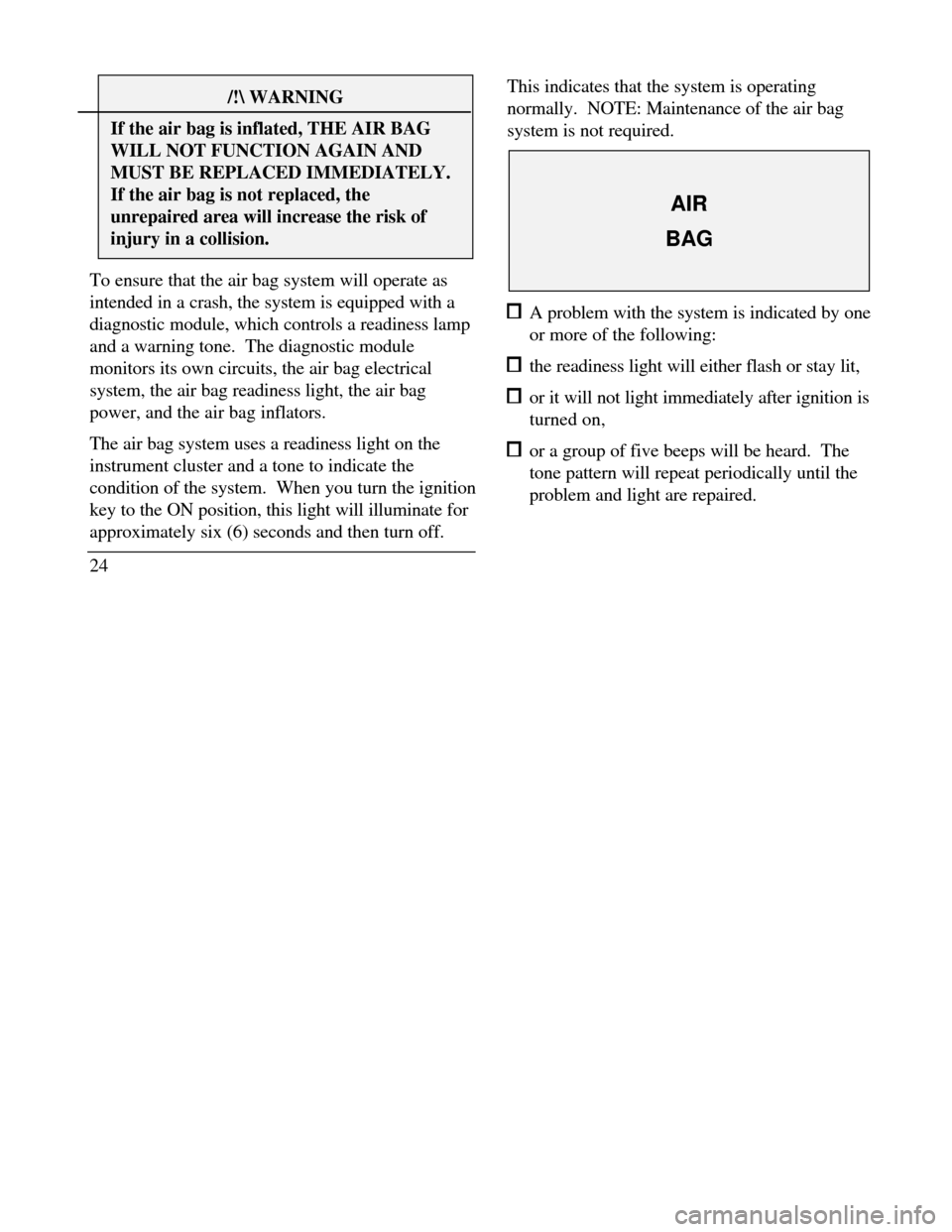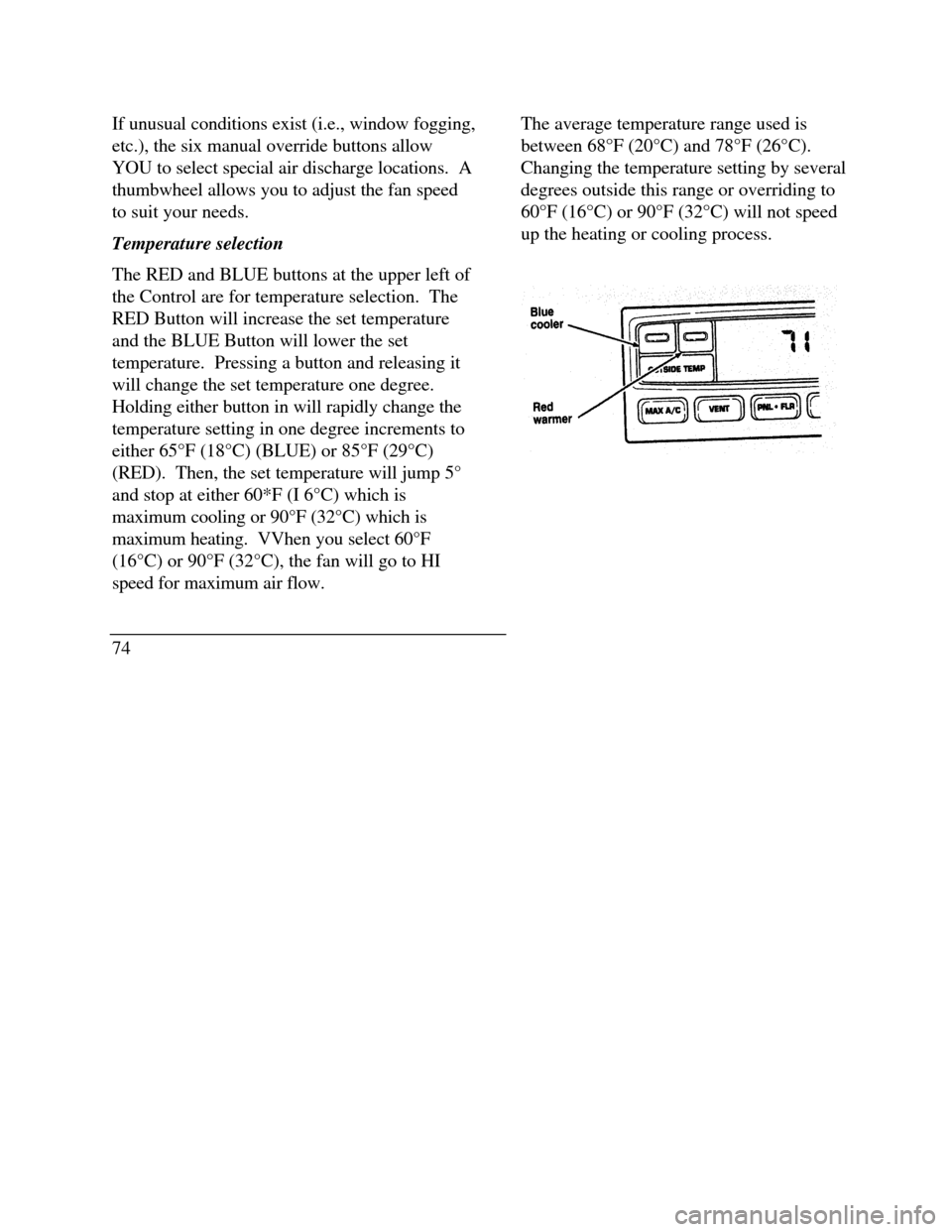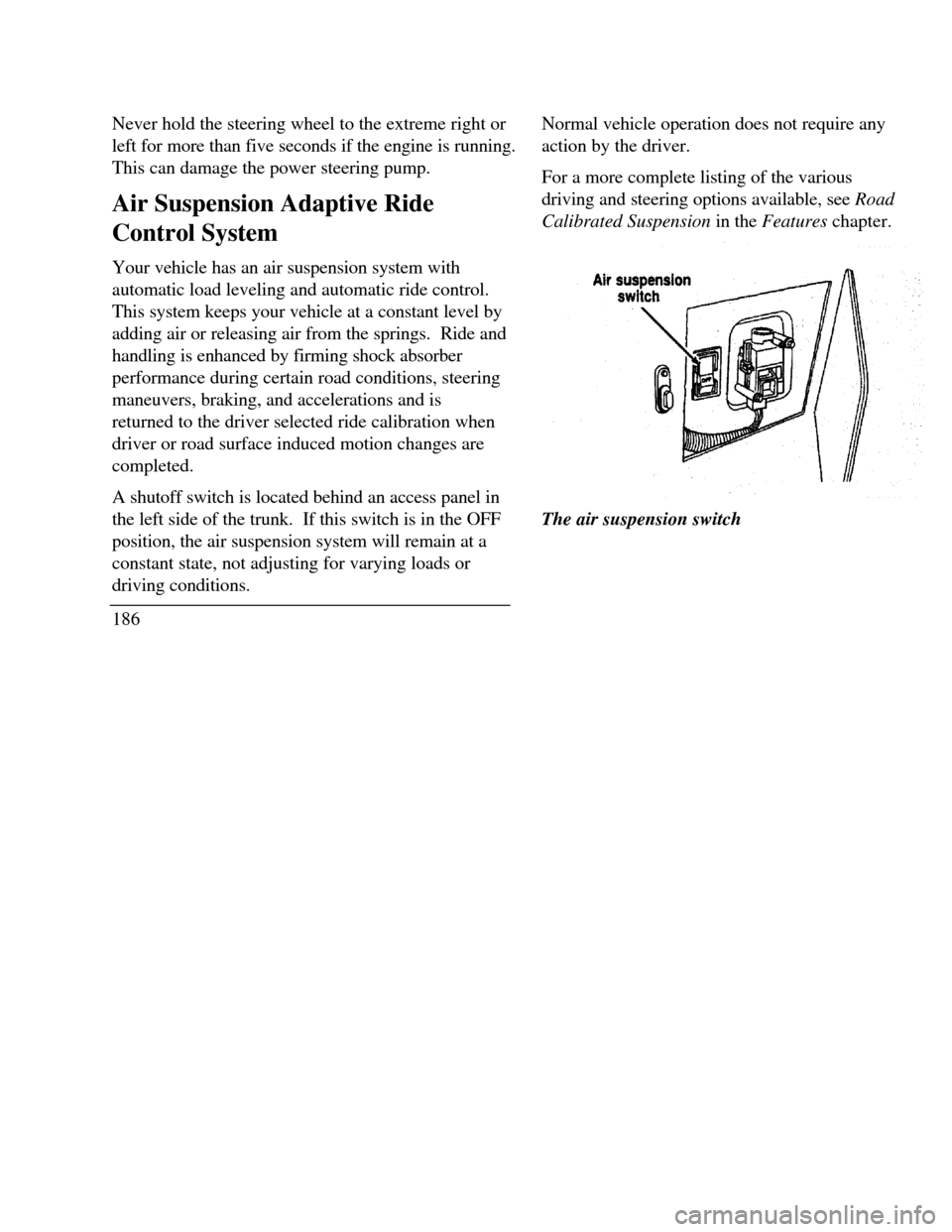Page 28 of 320

/! WARNINGIf the air bag is inflated, THE AIR BAGWILL NOT FUNCTION AGAIN ANDMUST BE REPLACED IMMEDIATELY.If the air bag is not replaced, theunrepaired area will increase the risk ofinjury in a collision.To ensure that the air bag system will operate as
intended in a crash, the system is equipped with a
diagnostic module, which controls a readiness lamp
and a warning tone. The diagnostic module
monitors its own circuits, the air bag electrical
system, the air bag readiness light, the air bag
power, and the air bag inflators.
The air bag system uses a readiness light on the
instrument cluster and a tone to indicate the
condition of the system. When you turn the ignition
key to the ON position, this light will illuminate for
approximately six (6) seconds and then turn off.
24This indicates that the system is operating
normally. NOTE: Maintenance of the air bag
system is not required.AIRBAG A problem with the system is indicated by one
or more of the following: the readiness light will either flash or stay lit, or it will not light immediately after ignition is
turned on, or a group of five beeps will be heard. The
tone pattern will repeat periodically until the
problem and light are repaired.
Page 53 of 320
Have the exhaust and body ventilation systems
checked whenever: your vehicle is raised for service the sound of the exhaust system changes your vehicle has been damaged in a collision
Improve your ventilation by keeping all air inlet
vents clear of snow, leaves, and other debris.
50If the engine is idling while you are stopped in an
open area for long periods of time, open the
windows at least one inch (2 . 5 cm). Also,
adjust the heating or air conditioning to bring in
outside air.
If you use the Electronic Automatic Climate
Control, set the fan speed selector dial to a
medium or high blower speed with the VENT or
PNL-FLR function buttons pressed.
Page 62 of 320
Air Bag Readiness Light
The air bag system uses a readiness light and
a tone to indicate the condition of the system.
The readiness light is in the instrument
cluster. When you turn the ignition key to the
ON position, this light will light up for six (6)
seconds and then turn off. This indicates that
the system is operating normally. NOTE:
Regularly scheduled maintenance of the air
bag system is not required.AIRBAGIf the light fails to Ruminate, continues to
flash, remains on, or you hear a beeping
sound, have the system serviced at your Ford
or Lincoln-Mercury dealer immediately.Anti-Theft Alarm Light
(If equipped)
This light flashes on and off when the ignition is
turned to the OFF position and any door is
opened. As soon as you lock the doors, the light
glows steadily. Within 30 seconds of closing all
the doors, the light goes out. This indicates that
the alarm system is armed.ANTI-THEFTSee Anti-Theft System in the Features chapter for
more information.
59
Page 76 of 320
The display windowThe AUTO temperature display
Automatic operation
Push the AUTOMATIC button and select the
desired temperature. The selected temperature
and AUTO will be shown in the display window.
The EATC will automatically heat or cool to
achieve the set temperature. Under normal
conditions, your EATC will need no additional
attention.When in AUTOMATIC and weather
conditions require heat, air will be sent to
the floor. But, a feature is included in
your EATC to prevent blowing cold air
to the floor if the engine coolant is not
warm enough to allow heating. In 3-1/2
minutes or less, the fan speed will start to
increase and the airflow will change to
the floor area.
73
Page 77 of 320

If unusual conditions exist (i.e., window fogging,
etc.), the six manual override buttons allow
YOU to select special air discharge locations. A
thumbwheel allows you to adjust the fan speed
to suit your needs.
Temperature selection
The RED and BLUE buttons at the upper left of
the Control are for temperature selection. The
RED Button will increase the set temperature
and the BLUE Button will lower the set
temperature. Pressing a button and releasing it
will change the set temperature one degree.
Holding either button in will rapidly change the
temperature setting in one degree increments to
either 65°F (18°C) (BLUE) or 85°F (29°C)
(RED). Then, the set temperature will jump 5°
and stop at either 60*F (I 6°C) which is
maximum cooling or 90°F (32°C) which is
maximum heating. VVhen you select 60°F
(16°C) or 90°F (32°C), the fan will go to HI
speed for maximum air flow.
74The average temperature range used is
between 68°F (20°C) and 78°F (26°C).
Changing the temperature setting by several
degrees outside this range or overriding to
60°F (16°C) or 90°F (32°C) will not speed
up the heating or cooling process.
Page 143 of 320
readings after a few days, perform a compass
adjustment.
Compass-Calibration
I .For optimum calibration, switch off all non-
essential electrical accessories (rear window
defrost, heater/air conditioning, map lamps,
wipers, etc.) and ensure all doors are shut.
2.Drive to an open, level area away from large
metallic objects or structures.
3.Insert an appropriate diameter rod (paper clip)
into the left switch access hole underneath the
compass module and press gently for 1-2
seconds until "CAL" and a direction appear on
the display.
1404. Release the button and drive in a circle
until "CAL" disappears from the display
(approx. 2-3 circles).
Compass-Zone Adjustment
1.The zone setting is factory pre-set to Zone
8. Refer to the Zone Map in this manual to
verify the correct compass zone setting for
your geographical location.
Page 146 of 320

THIS DEVICE COMPLIES WITH FCC RULES,
PART 15. OPERATION IS SUBJECT TO THE
FOLLOWING TWO CONDITIONS: (1) THIS
DEVICE MAY NOT CAUSE HARMFUL
INTEREFERENCE AND (2) THIS DEVICE
MUST ACCEPT ANY INTEREFERENCE THAT
MAY BE RECEIVED, INCLUDING
INTEREFERENCE THAT MAY CAUSE
UNDESIRABLE OPERATION.
Maintenance Warning
The "Low Tire Pressure" warning will illuminate
and stay on when one of your vehicle's tires drops
below 18 psi (124 kps). The warning light will also
come on and stay lit if the Pressure Alert System has
malfunctioned.
If this warning appears, check the pressure in your
tires at the earliest possible convenience and adjust
any tire that is low to the recommended air pressure
level. This information can be found on the Service
Station Information page at the back of this manual
or on the driver's door placard.If the warning remains on after you have
adjusted the tires to recommended air pressure
levels, take your vehicle to an authorized
Lincoln/Mercury dealer for service.
Flat Tire Warning
If the sensors detect a tire pressure lower than I
0 psi (68 kps), the "Low Tire Pressure" warning
will flash repeatedly in the overhead console and
the message "Warning Low Tire Pressure" will
be displayed in the Message Center, indicating
an impending flat tire. If this condition occurs,
your Securitire requires service as soon as
possible. Refer to Servicing Your Secutitires.
NOTE: The Pressure Alert System will
activate only when the vehicle is moving faster
than 10 mph (15 km/h).
143
Page 189 of 320

Never hold the steering wheel to the extreme right or
left for more than five seconds if the engine is running.
This can damage the power steering pump.
Air Suspension Adaptive Ride
Control System
Your vehicle has an air suspension system with
automatic load leveling and automatic ride control.
This system keeps your vehicle at a constant level by
adding air or releasing air from the springs. Ride and
handling is enhanced by firming shock absorber
performance during certain road conditions, steering
maneuvers, braking, and accelerations and is
returned to the driver selected ride calibration when
driver or road surface induced motion changes are
completed.
A shutoff switch is located behind an access panel in
the left side of the trunk. If this switch is in the OFF
position, the air suspension system will remain at a
constant state, not adjusting for varying loads or
driving conditions.
186Normal vehicle operation does not require any
action by the driver.
For a more complete listing of the various
driving and steering options available, see Road
Calibrated Suspension in the Features chapter.Air suspension switchThe air suspension switch